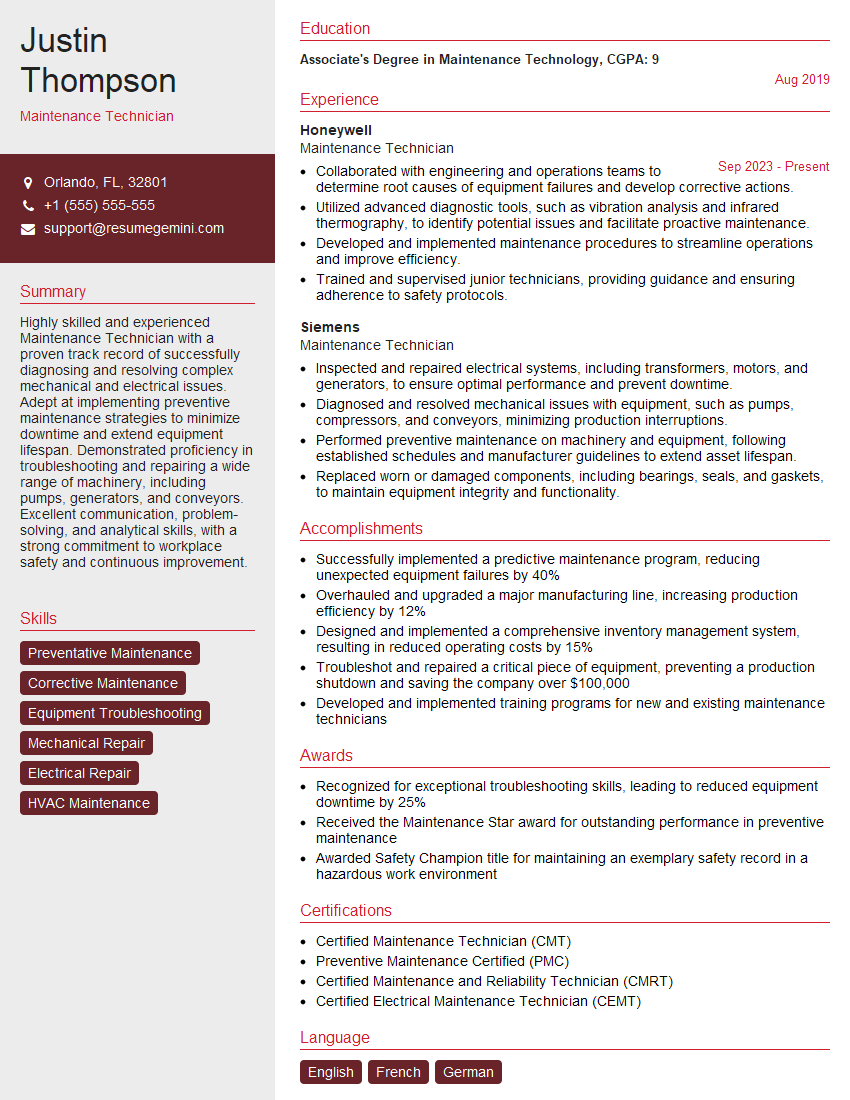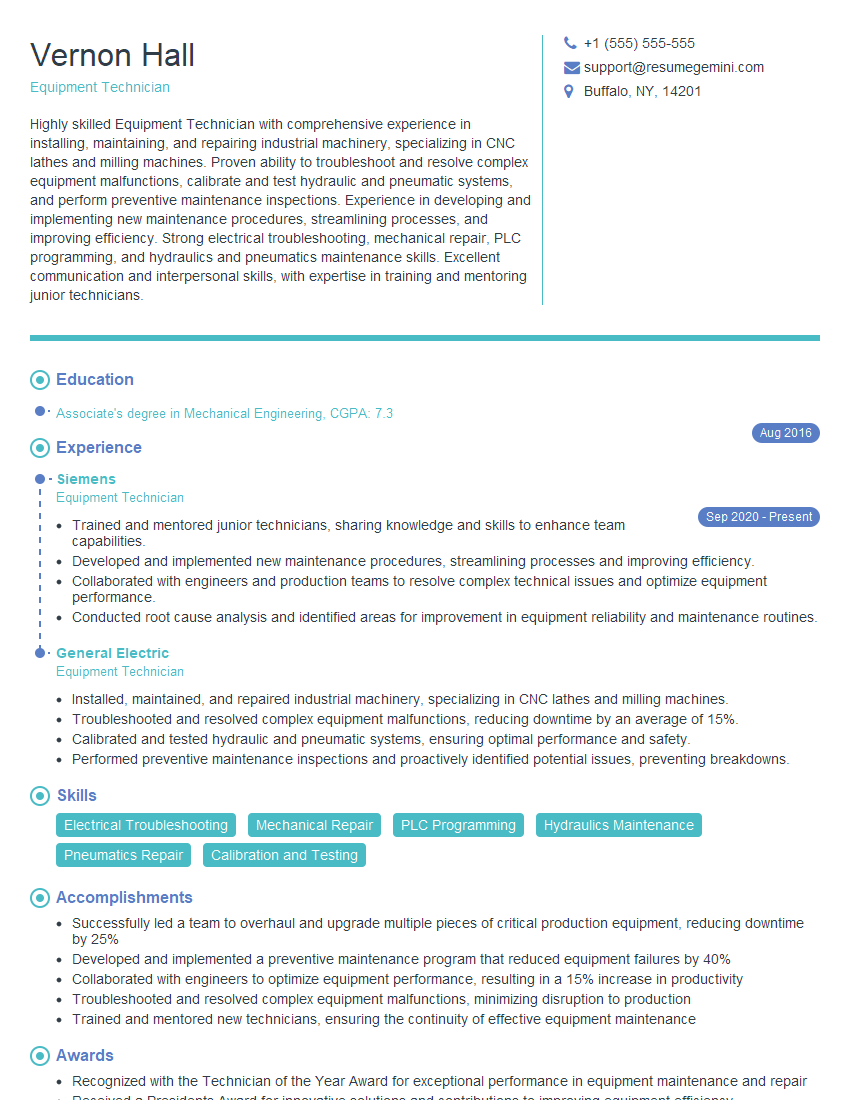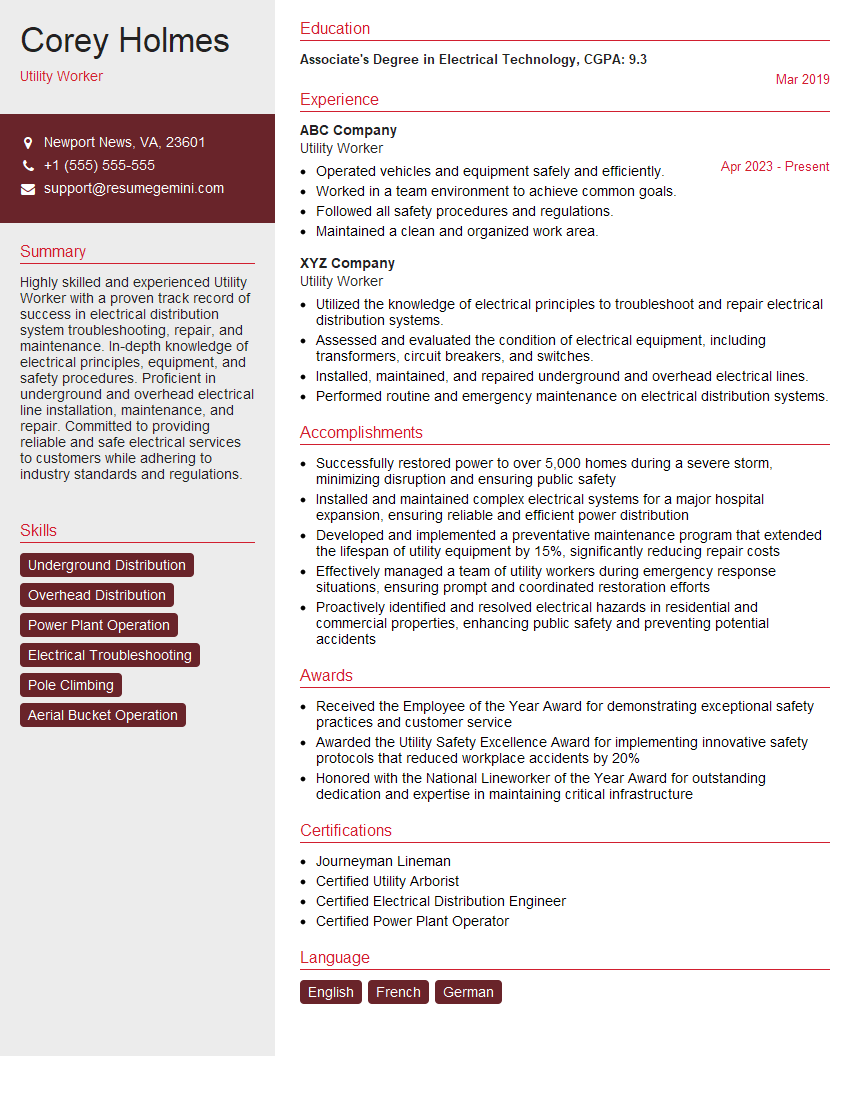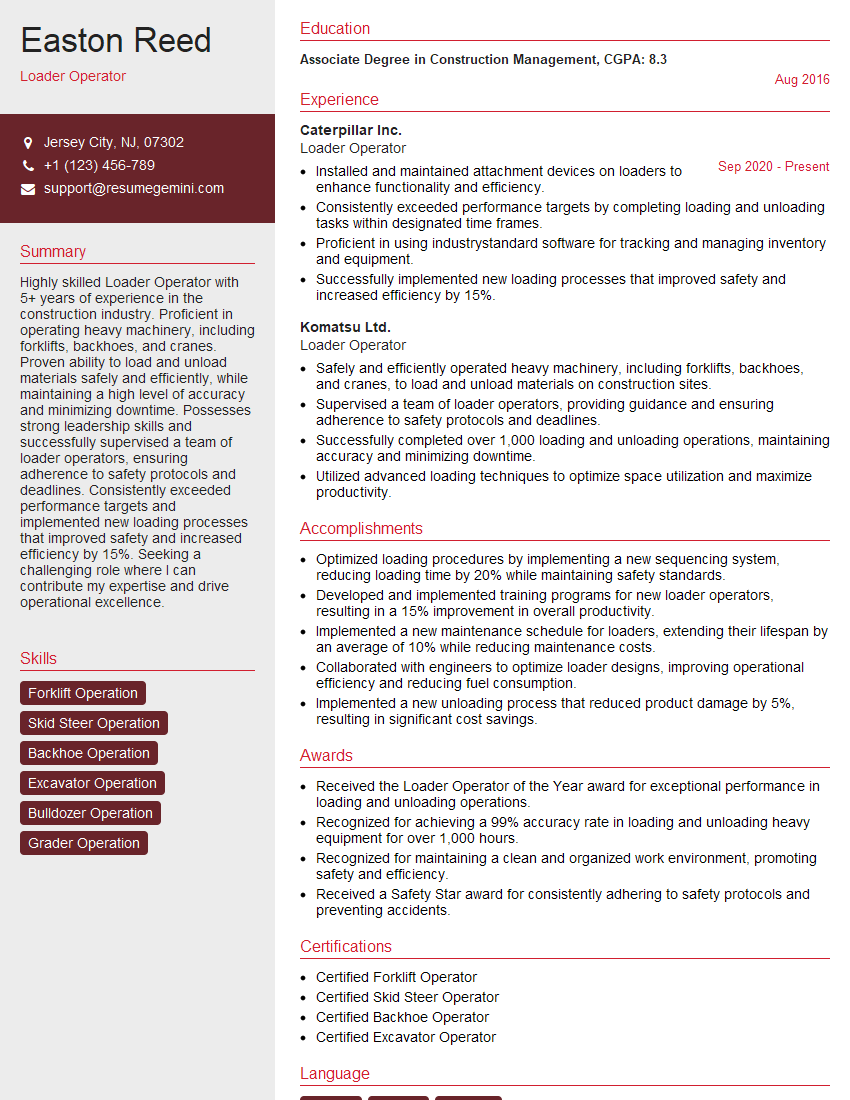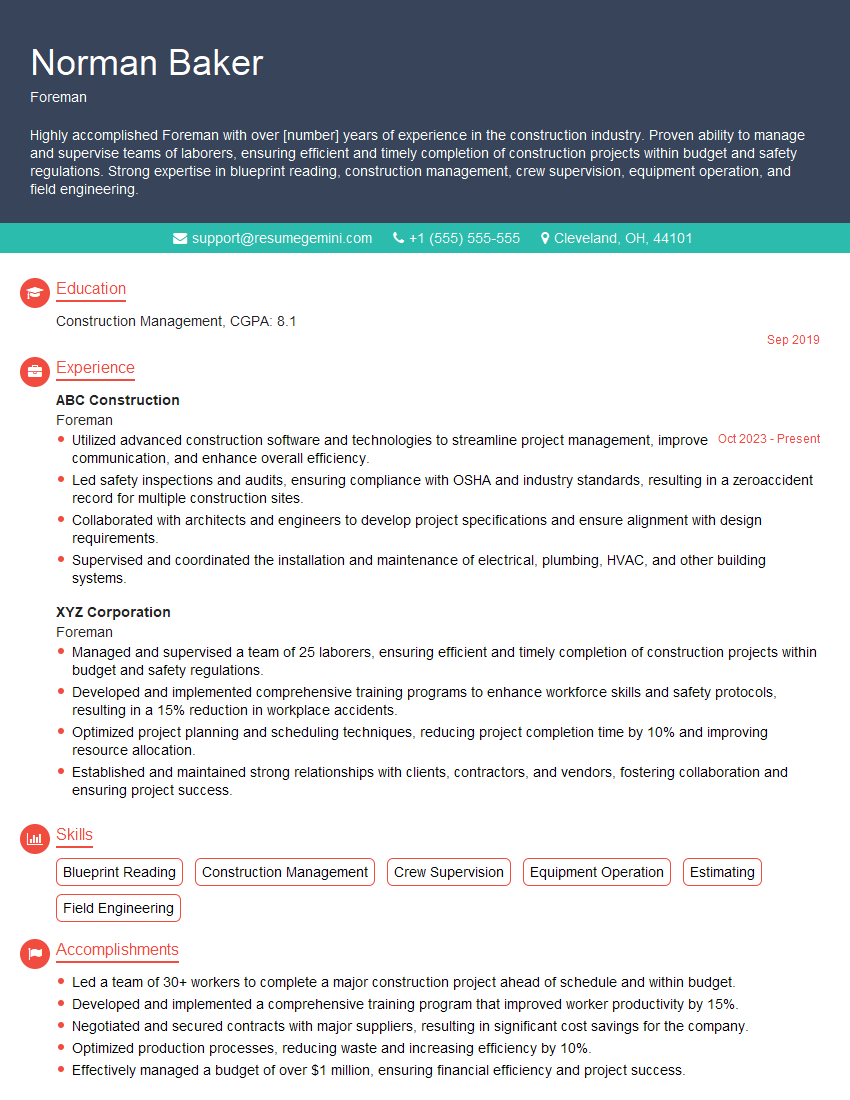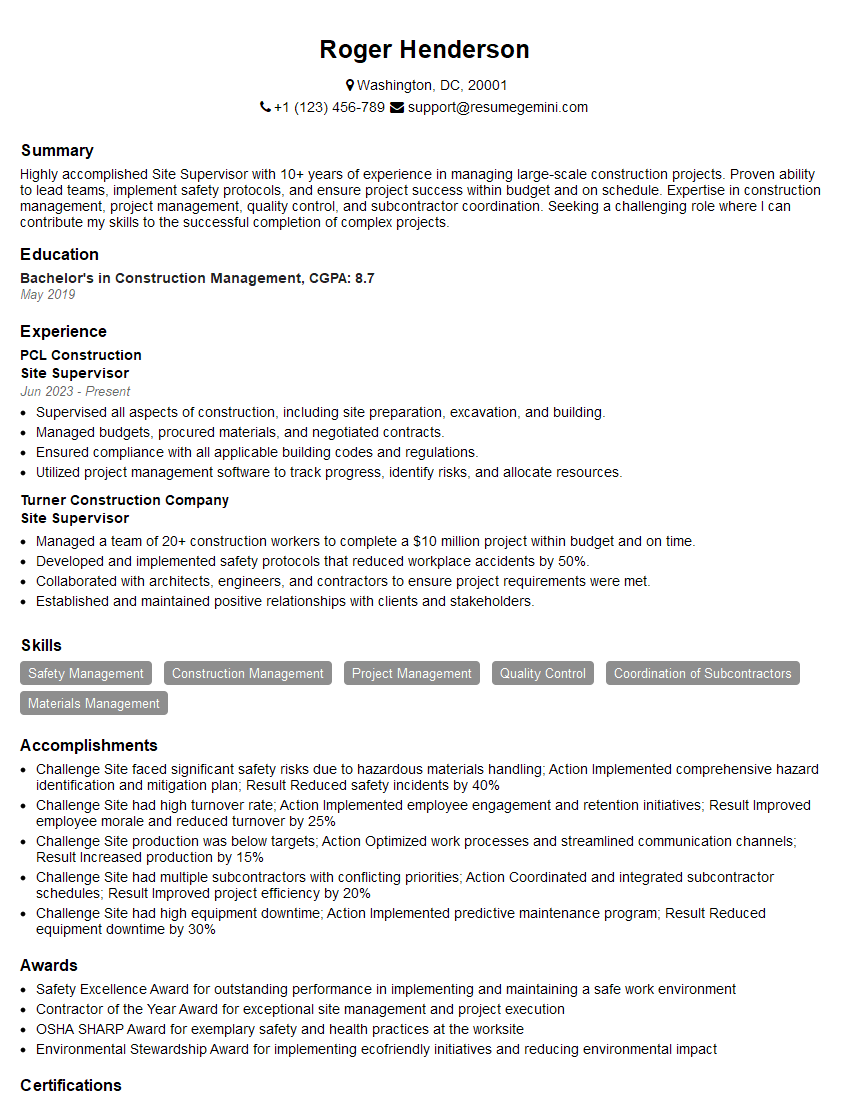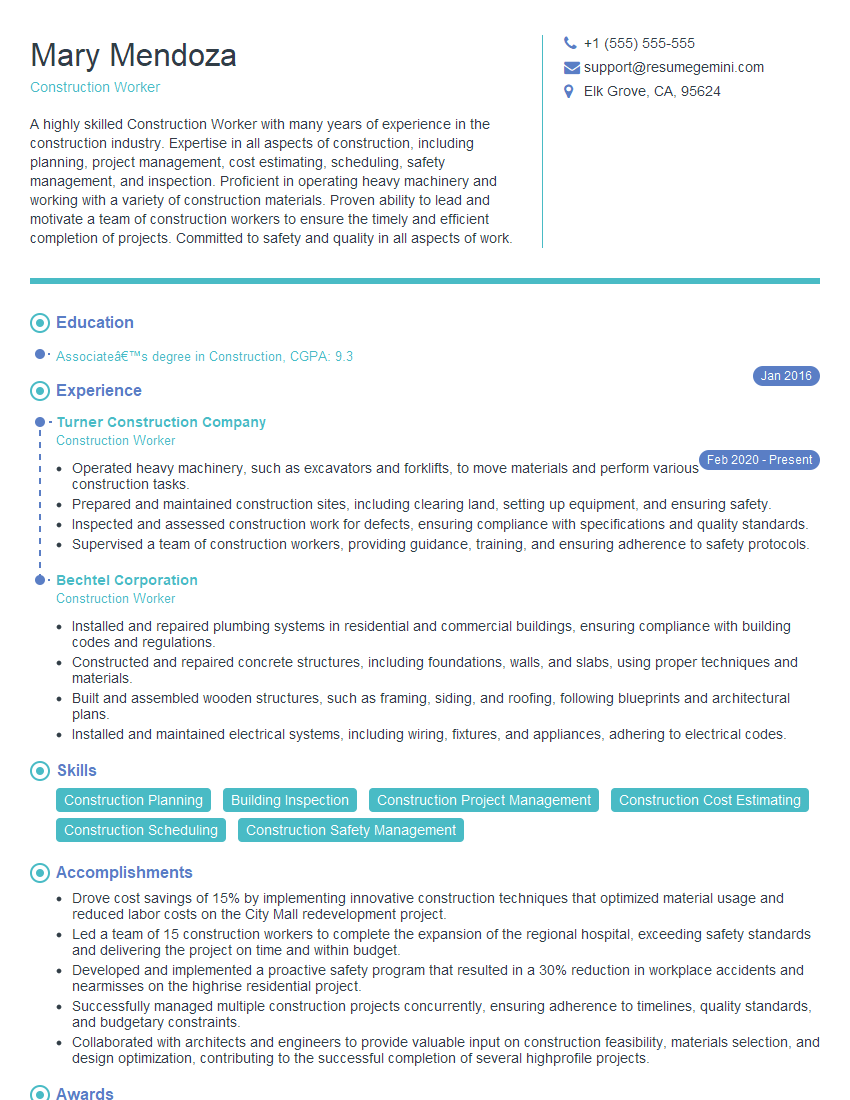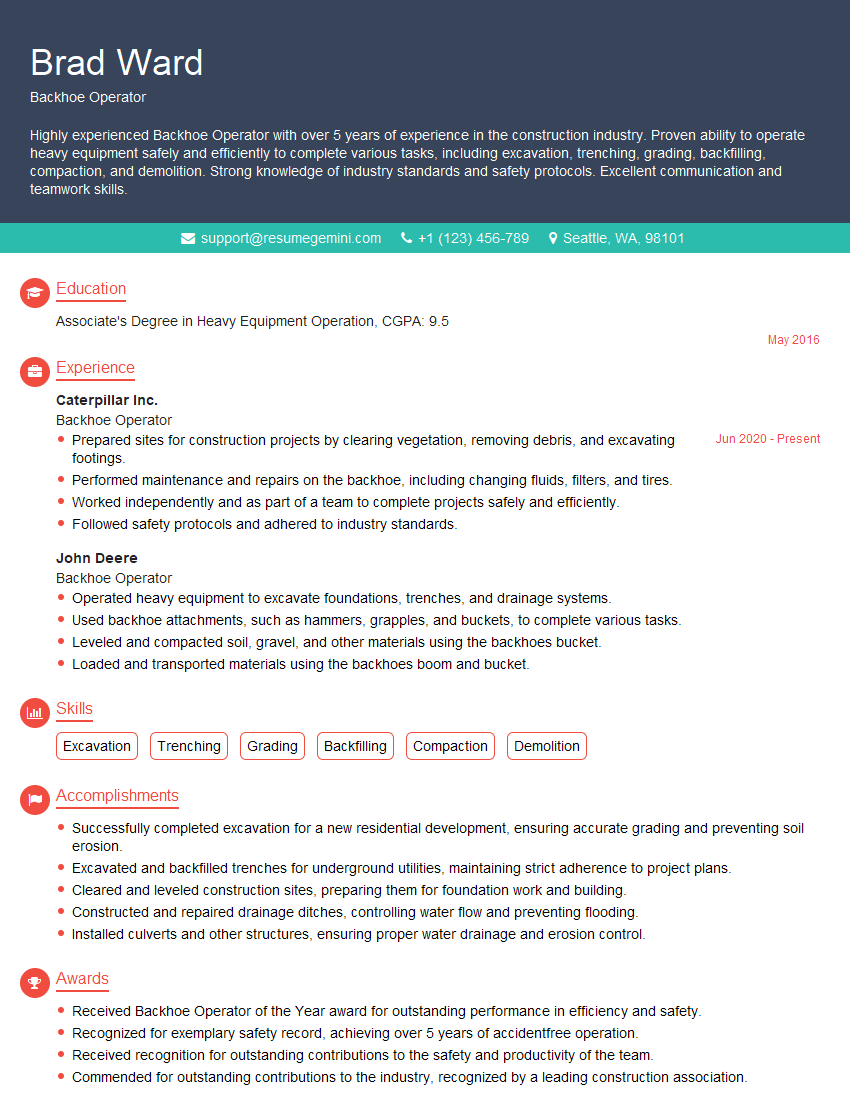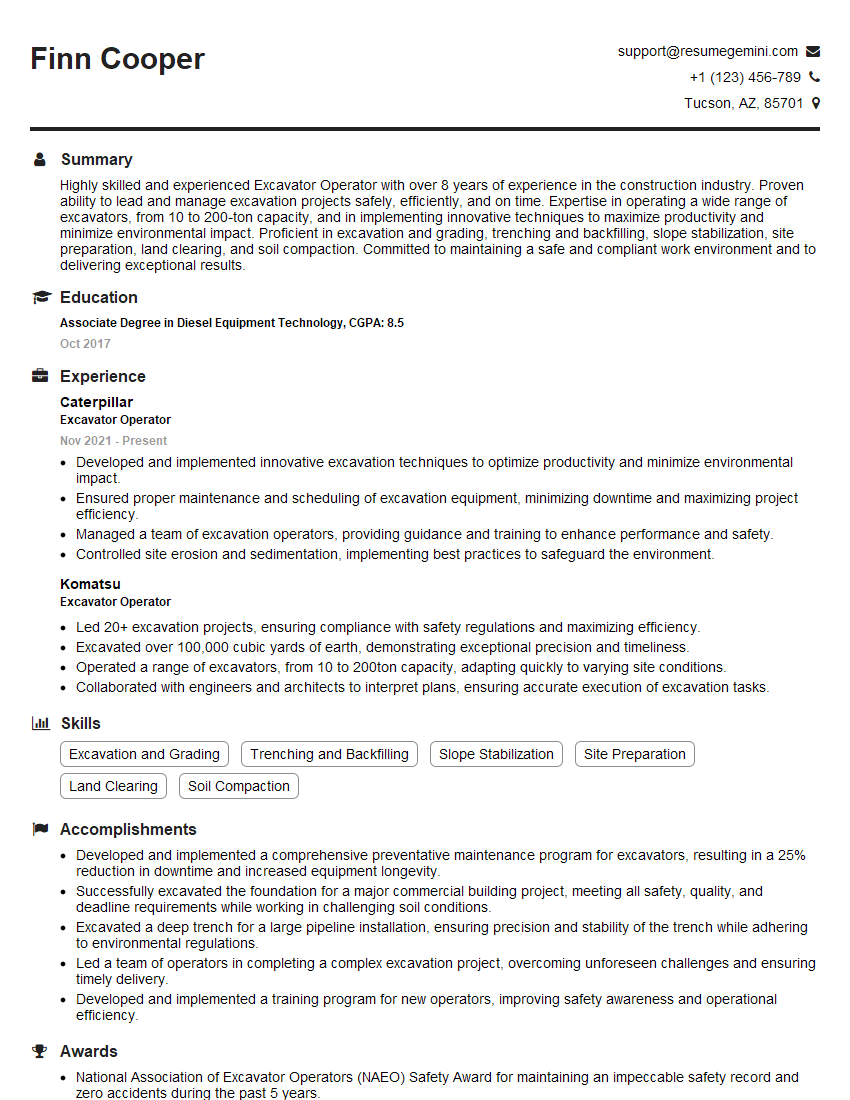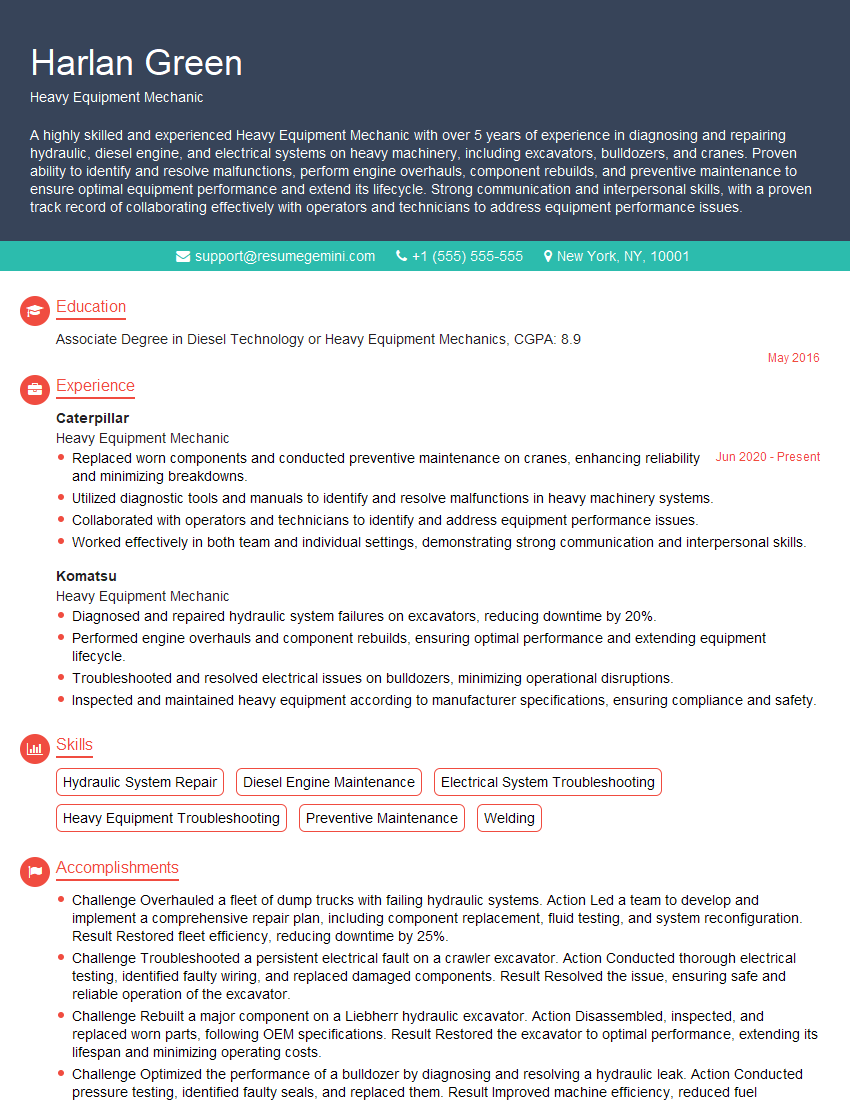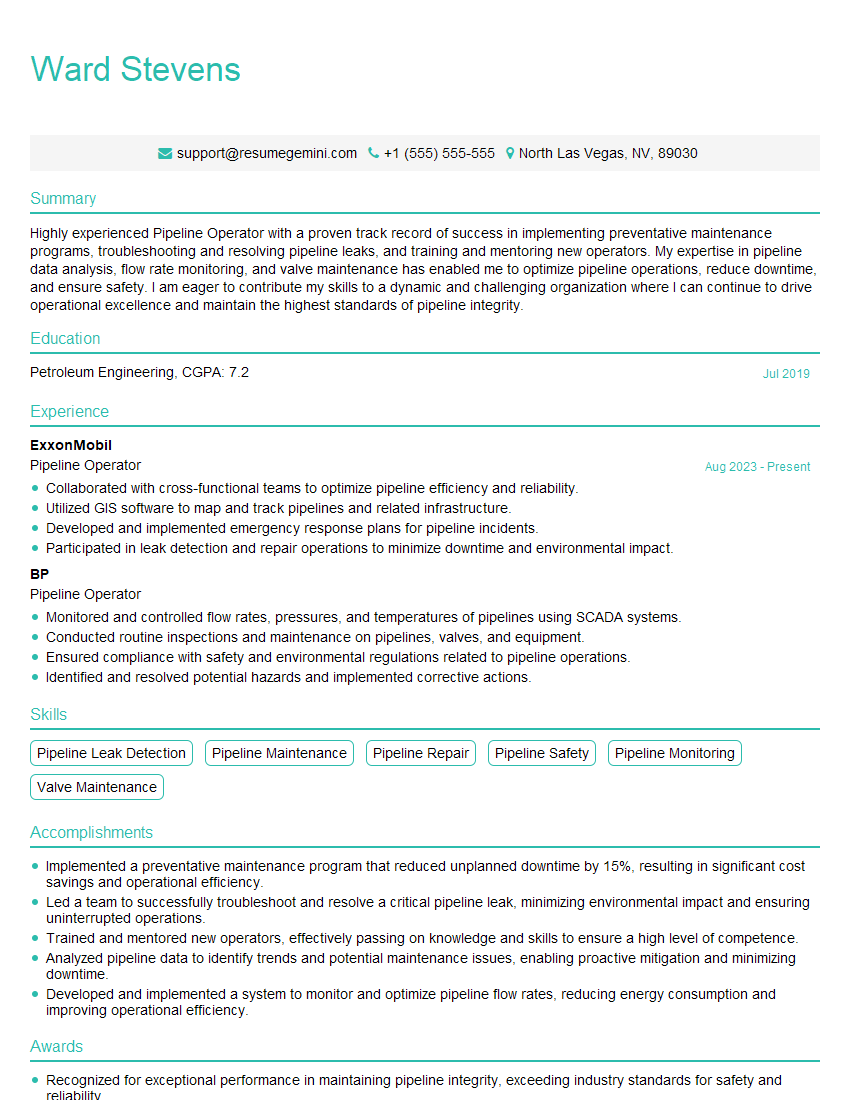Interviews are opportunities to demonstrate your expertise, and this guide is here to help you shine. Explore the essential Loader Backhoe Operation interview questions that employers frequently ask, paired with strategies for crafting responses that set you apart from the competition.
Questions Asked in Loader Backhoe Operation Interview
Q 1. Describe your experience operating a loader backhoe.
I have over ten years of experience operating loader backhoes in various construction and landscaping projects. My experience encompasses a wide range of tasks, from excavating foundations and trenches to loading materials and grading sites. I’m proficient in operating both smaller, more maneuverable machines, and larger, heavier-duty models depending on project requirements. For example, on one project, I used a compact backhoe to carefully excavate around existing utilities while on another, I utilized a larger machine to dig the foundation for a substantial commercial building. This diverse experience has allowed me to develop a strong understanding of machine capabilities and limitations, enabling me to adapt my approach to any site conditions.
Q 2. What safety procedures do you follow when operating a loader backhoe?
Safety is my paramount concern. Before starting any work, I always conduct a thorough pre-operational inspection. This includes checking fluid levels (hydraulic fluid, engine oil, coolant), tire pressure, and the overall condition of the machine for any damage. I ensure all safety devices, such as lights, seatbelts, and emergency brakes, are functioning correctly. During operation, I maintain awareness of my surroundings, paying close attention to other workers, obstacles, and underground utilities. I never operate the machine near anyone who is not properly wearing hearing and safety protection. I use hand signals effectively to communicate with spotters and other personnel and always follow the posted speed limits on the site. Finally, I adhere strictly to all company safety regulations and wear appropriate personal protective equipment (PPE), including safety glasses, hearing protection, and steel-toed boots.
Q 3. Explain the different attachments used with a loader backhoe and their applications.
Loader backhoes are versatile machines, and their functionality is greatly expanded by the use of various attachments. Some common attachments include:
- Buckets: These are the most common attachment, used for digging, loading, and moving materials. Different bucket sizes and shapes are available for various applications.
- Rippers: Used to break up hard ground or compacted soil, improving the efficiency of digging and excavation.
- Augers: Drill holes for post holes, planting trees, or other applications.
- Hydraulic Hammers: Used for breaking up concrete, rocks, or other hard materials.
- Grapples: Designed to handle and lift loose materials such as logs, brush, or scrap metal.
- 4 in 1 Buckets: Combine the functions of a bucket, a clam shell, a bulldozer blade, and a scraper, ideal for various earth-moving tasks.
The choice of attachment depends entirely on the specific task at hand. For example, a ripper would be necessary for breaking up rocky soil before trenching, while an auger would be used for creating precisely sized holes for fence posts.
Q 4. How do you perform pre-operational checks on a loader backhoe?
Pre-operational checks are crucial for ensuring the safe and efficient operation of the loader backhoe. My routine includes:
- Visual Inspection: Checking for any visible damage, leaks, or loose components.
- Fluid Levels: Verifying engine oil, hydraulic fluid, coolant, and fuel levels are within the acceptable range.
- Tire Pressure: Ensuring proper inflation for optimal performance and stability.
- Brakes and Steering: Testing the functionality of the brakes and steering system.
- Safety Devices: Confirming that safety lights, seatbelts, and other safety mechanisms are in working order.
- Attachments: Inspecting any attached tools for damage or wear, ensuring proper and safe attachment.
- Operational Test: Briefly operating the machine to ensure all functions are smooth and responsive.
If any issues are detected during this process, I address them before commencing operation to prevent potential accidents or breakdowns. This meticulous approach ensures the machine is in top condition and ready for safe and effective operation.
Q 5. What are the common maintenance tasks for a loader backhoe?
Regular maintenance is essential for prolonging the lifespan and performance of a loader backhoe. Key maintenance tasks include:
- Daily Checks: Fluid levels, tire pressure, visual inspection for leaks or damage.
- Weekly Checks: More thorough inspection of wear and tear on critical components such as the bucket, hydraulic lines, and undercarriage.
- Monthly Checks: Lubrication of moving parts, including pins, bushings, and linkages.
- Periodic Servicing: Scheduled servicing involves more complex tasks such as filter changes, fluid flushes, and component replacements as per the manufacturer’s recommendations.
I am familiar with the preventative maintenance schedules and have experience performing many of these tasks myself. Regular maintenance significantly reduces the risk of breakdowns and costly repairs while ensuring optimal machine performance and safety.
Q 6. How do you handle different soil types while operating a loader backhoe?
Different soil types require different operating techniques. For example:
- Clay Soil: Can be very sticky and difficult to dig. I use a slower digging speed and ensure the bucket is cleaned frequently to prevent build-up.
- Sandy Soil: Tends to be loose and may collapse easily. I’ll dig carefully, perhaps in smaller stages, to avoid cave-ins and ensure proper shoring if necessary.
- Rocky Soil: Requires the use of a ripper or hydraulic hammer to break up the rock before digging, demands careful consideration to prevent damage to the bucket.
- Loose Soil: Requires proper shoring and caution to prevent collapse.
Experience allows me to quickly assess soil type and adjust my technique to ensure efficient and safe operation. Understanding the characteristics of different soils is essential to prevent equipment damage and ensure safe excavation practices.
Q 7. Describe your experience with trenching and backfilling.
I have extensive experience in trenching and backfilling, adhering to all safety regulations and best practices. When trenching, I always ensure proper shoring or shoring support is in place to prevent cave-ins, especially in unstable soils. I carefully plan the trench’s location, considering the presence of underground utilities. Before backfilling, I inspect the trench to ensure that any utilities or pipes have been properly protected. I use layered compaction techniques to ensure the backfill is properly settled and stable, preventing future settling or damage to any underground utilities. I also have experience in the utilization of different backfilling methods such as using a bucket or using a specialized backfilling attachment. The specific method and materials used depend on the requirements of the project. This ensures that the completed trench is structurally sound and safe.
Q 8. How do you ensure the stability of the loader backhoe during operation?
Ensuring stability during loader backhoe operation is paramount for safety and efficient work. It involves understanding and actively managing several factors. Think of it like balancing a seesaw – you need to distribute the weight evenly to prevent tipping.
- Proper Ground Conditions: Avoid operating on unstable surfaces like soft soil or slopes. Assess the ground before you begin, and if necessary, use mats or other stabilizing materials. I once had to delay a project because the soil was too soft; waiting for it to dry saved us from a potential accident.
- Weight Distribution: Distribute the load evenly by keeping the center of gravity as close to the machine’s center as possible. Avoid extending the boom or bucket excessively, especially when lifting heavy materials. Imagine lifting a heavy box – extending your arm too far makes it much harder and riskier.
- Outriggers (if equipped): Always extend outriggers when performing heavy lifting or stabilizing operations, especially when working on uneven terrain. Outriggers act as additional points of support, significantly improving stability. They’re like extra legs for the machine.
- Counterweight: Be mindful of the counterweight’s position and its effect on stability. The counterweight helps balance the load, so ensure it’s properly adjusted and secured.
- Smooth Operations: Avoid sudden movements or jerky actions. Smooth, controlled movements minimize the risk of instability. Think of driving a car – sudden braking or acceleration can cause loss of control; the same applies to a backhoe.
Q 9. Explain your understanding of load capacity and weight distribution.
Load capacity and weight distribution are critical for safe and efficient loader backhoe operation. Load capacity refers to the maximum weight the machine can safely lift, while weight distribution relates to how that weight is balanced across the machine’s axles and chassis. Exceeding the load capacity or having poor weight distribution can lead to tipping or structural damage.
For example, the manufacturer’s specifications will state the maximum weight the backhoe can lift at different boom extensions. Ignoring this could lead to a catastrophic failure. Similarly, lifting a heavy load with the boom fully extended significantly increases the risk of tipping compared to lifting the same load with the boom closer to the machine.
I always double-check the load chart before commencing any task to ensure that the load I’m about to handle is within the machine’s capabilities. Knowing the weight of the material being moved is crucial. I also make sure to evenly distribute the load by making sure the bucket is centered and the boom is not excessively extended or angled.
Q 10. How do you handle unexpected mechanical issues while operating a loader backhoe?
Handling unexpected mechanical issues requires a calm and systematic approach. Safety is always the top priority.
- Immediate Assessment: First, I’d assess the situation to determine the severity of the issue and the potential safety hazards. If it’s a minor issue, I might be able to proceed cautiously; however, if it’s serious, I would shut down the machine immediately.
- Safety Precautions: Secure the machine and area. This includes turning off the engine, setting the parking brake, and warning nearby personnel about the situation.
- Troubleshooting: Depending on my training and the nature of the issue, I might attempt basic troubleshooting. However, I would never attempt to repair the machine myself beyond basic checks unless I am qualified to do so.
- Reporting and Communication: I would immediately report the issue to my supervisor, providing details about the malfunction and the steps I’ve taken. It’s crucial to accurately document everything.
- Professional Repair: If the issue is beyond my scope of expertise, I’d wait for qualified personnel to arrive and repair the machine.
During one project, the hydraulic line sprung a leak. I immediately shut down the machine, contacted the supervisor and followed safety protocol to prevent further damage. Professional help was called to fix the leak and we resumed the job as soon as possible.
Q 11. What are the signs of a malfunctioning hydraulic system?
A malfunctioning hydraulic system presents several warning signs that a trained operator should recognize.
- Slow or sluggish movements: This suggests a leak in the hydraulic lines or low hydraulic fluid.
- Unusual noises: Grinding, squealing, or whining sounds may indicate pump failure, worn seals, or other internal problems.
- Leaks: Hydraulic fluid leaks are a clear sign of damage to hoses, lines, or seals. Fluid leaks should be addressed immediately.
- Overheating: Excessive heat around the hydraulic components can result from low fluid levels, restricted flow, or component failure.
- Inconsistent performance: Intermittent functioning of hydraulic systems may point towards electrical problems or contamination.
Identifying these signs early allows for timely intervention and prevents more significant damage. Early detection prevents catastrophic failure and costly repairs.
Q 12. How do you properly shut down a loader backhoe after operation?
Proper shutdown procedure is essential for both machine maintenance and safety. It’s a step-by-step process designed to ensure the machine is safely secured and ready for future use.
- Lower all attachments: Lower the boom and bucket to the ground in a stable position.
- Engage the parking brake: Firmly engage the parking brake to prevent accidental movement.
- Turn off the engine: Turn the ignition key to the ‘off’ position.
- Disengage any implements: Ensure all hydraulic functions are disengaged.
- Check for leaks: Visually check the machine for any signs of fluid leaks.
- Clean the machine: Remove any debris or mud from the machine.
- Secure the machine: If left unattended, the machine should be parked in a safe and secure location.
Following this procedure minimizes the risk of accidents or damage and extends the lifespan of the machine.
Q 13. Describe your experience working with GPS or other guidance systems.
My experience with GPS and other guidance systems is extensive. I’ve used GPS-guided systems on several projects to improve accuracy and efficiency. These systems typically provide real-time positioning data, allowing for precise control over the backhoe’s movements.
For instance, I worked on a project where we needed to excavate a trench with very precise dimensions. Using a GPS-guided system ensured the trench was dug to the exact specifications, minimizing errors and reducing rework. It was far more accurate than traditional methods.
I’m also familiar with other guidance systems, such as laser levels, which help maintain consistent grading and leveling during excavation work. These technologies are becoming increasingly important in the construction industry for maximizing efficiency and ensuring accuracy.
Q 14. How do you maintain a clean and organized work area?
Maintaining a clean and organized work area is crucial for safety, efficiency, and professionalism. It’s about creating a space that minimizes hazards and allows for smooth operation.
- Regular Clean-up: I consistently clear debris and material from around the machine and the work area throughout the day, not just at the end. This prevents tripping hazards and keeps the work area safe.
- Organized Storage: Tools, materials, and equipment should be stored in designated areas to prevent clutter and accidental damage. I use designated toolboxes and keep them organized.
- Fueling and maintenance: Proper fueling and regular maintenance are a key part of maintaining a clean and orderly workspace. Spills should be cleaned immediately.
- End of shift cleanup: At the end of each day, I make sure the area is completely cleared and all equipment is properly stored. This is a crucial step in preventing accidents and creating a professional impression.
A clean workspace significantly improves efficiency and reduces the risk of accidents. A tidy work area is a safe work area.
Q 15. What are your strategies for efficient material handling?
Efficient material handling with a loader backhoe hinges on strategic planning and execution. It’s not just about moving dirt; it’s about minimizing movements, optimizing load sizes, and preventing unnecessary wear and tear on the machine.
- Pre-planning: Before I even start the engine, I assess the site. I determine the most efficient route for transporting materials, considering factors like terrain, obstacles, and the location of the dumping area. For example, if I’m excavating a trench, I’ll plan the swing path of the backhoe to minimize repositioning.
- Optimized Loading: I avoid overloading the bucket. Overloading reduces maneuverability, increases fuel consumption, and strains the machine. I aim for a consistently full but not overflowing bucket for each load.
- Smooth Operations: Sudden jerky movements waste fuel and increase wear on the hydraulic system. I prioritize smooth, controlled movements. Think of it like driving a car—smooth acceleration and braking save fuel and reduce wear and tear.
- Bucket Positioning: Correct bucket positioning is crucial for efficient loading and dumping. Before dumping, I position the bucket appropriately over the designated area to avoid spillage or the need for multiple dumping attempts.
For example, on a recent project involving the excavation of a large foundation, I meticulously planned the loading and dumping areas to minimize travel distances, resulting in a significant increase in productivity and reduced fuel usage. This careful approach ensured that the project remained on schedule and within budget.
Career Expert Tips:
- Ace those interviews! Prepare effectively by reviewing the Top 50 Most Common Interview Questions on ResumeGemini.
- Navigate your job search with confidence! Explore a wide range of Career Tips on ResumeGemini. Learn about common challenges and recommendations to overcome them.
- Craft the perfect resume! Master the Art of Resume Writing with ResumeGemini’s guide. Showcase your unique qualifications and achievements effectively.
- Don’t miss out on holiday savings! Build your dream resume with ResumeGemini’s ATS optimized templates.
Q 16. Describe your experience working in confined spaces with a loader backhoe.
Working in confined spaces with a loader backhoe demands exceptional skill, precision, and a heightened awareness of safety. Space limitations necessitate careful maneuvering and precise control. I’ve worked in numerous situations with limited access, such as urban construction sites and tight residential areas.
- Awareness of Surroundings: Before I even begin, I thoroughly survey the area. I identify all potential hazards, including overhead obstructions, underground utilities, and any nearby structures. I check the clearance around the machine carefully to avoid any collisions.
- Gradual Movements: In confined areas, I use slow and deliberate movements. Quick, jerky maneuvers can be extremely dangerous in restricted space. I utilize the machine’s controls with precision and finesse.
- Spotters: In very confined or hazardous spaces, I always utilize spotters. A second pair of eyes is crucial in areas with limited visibility or if obstacles are close to the machine’s operating radius.
- Communication: Clear communication is key, especially when working with other operators or laborers in close proximity. Hand signals and radio communication are vital in minimizing the risk of accidents.
One instance involved excavating a narrow trench for utility lines in a residential street. There was minimal space for maneuvering, and I needed to carefully avoid damaging nearby infrastructure and parked vehicles. My slow and deliberate movements and constant vigilance prevented any incidents.
Q 17. How do you manage fuel consumption while operating a loader backhoe?
Fuel efficiency is a major factor in loader backhoe operation, both economically and environmentally. My strategies to manage fuel consumption involve a combination of operational techniques and preventative maintenance.
- Appropriate Engine Speed: I avoid unnecessarily high engine RPMs. The machine often doesn’t require maximum power for many tasks, and operating at a lower, more efficient speed significantly reduces fuel consumption.
- Smooth Operation: As mentioned before, avoiding jerky movements is crucial. Smooth, controlled acceleration and deceleration are significantly more fuel-efficient.
- Load Matching: I select the right gear for the load and terrain. This prevents the engine from struggling, thus improving fuel efficiency.
- Preventative Maintenance: Regular maintenance, including filter changes and tune-ups, keeps the engine running at peak performance. A well-maintained engine uses less fuel.
- Idle Time Minimization: I minimize idle time by shutting off the engine when the machine is not in use for extended periods. I also try to complete the entire task without needing to restart frequently.
For example, on a large-scale earthmoving project, by consistently employing these fuel-saving techniques, we achieved a noticeable reduction in overall fuel costs, demonstrating a significant return on investment in terms of operational efficiency.
Q 18. Explain your understanding of different digging techniques.
Digging techniques vary depending on the soil conditions, the depth and width of the excavation, and the desired outcome. I’m proficient in several techniques:
- Sidecasting: This involves digging with the bucket positioned to the side of the machine, moving the excavated material to one side. It’s efficient for creating trenches and wide excavations.
- Face Digging: Used for smaller, deeper excavations, the bucket digs straight ahead and the material is moved away from the hole’s face.
- Swing Casting: This involves digging and simultaneously swinging the bucket to move the material away from the hole. Useful for clearing larger areas or creating wide trenches.
- Undercutting: A specialized technique where the bucket digs under a slope or embankment to help prevent collapse. This is crucial for safety and stability.
The choice of digging technique is crucial for efficiency and safety. Using the wrong technique can lead to poor excavation quality, increased effort and, in extreme cases, even accidents. I carefully select the appropriate method based on a thorough assessment of the ground conditions and specific task requirements.
Q 19. How do you ensure the safety of other workers on the site?
Safety is paramount on any job site. My responsibility extends to ensuring the safety of all workers, not just myself. I employ several strategies:
- Site Awareness: I constantly monitor my surroundings and the activities of other workers. I anticipate potential hazards and take steps to mitigate them.
- Clear Communication: I maintain open communication with other workers, using hand signals, radio communication, or verbal warnings to alert them of my movements and potential risks.
- Proper Signaling: Before starting any significant operation, I use appropriate signals to alert workers of the impending movement. I adhere to all traffic and signaling standards.
- Maintaining Safe Distances: I maintain safe distances from other workers and equipment. I never operate near others without ensuring adequate clearance.
- Reporting Hazards: I immediately report any unsafe conditions or potential hazards to my supervisor to facilitate appropriate action and mitigation.
For example, I once noticed a worker walking too close to my excavation area. I immediately stopped the machine, communicated with the worker, and explained the potential dangers before resuming my work. Preventing accidents through proactive communication and awareness is a key aspect of my job.
Q 20. Describe your experience working under pressure or in tight deadlines.
Working under pressure and tight deadlines is a regular part of my job. I manage these situations through effective planning, efficient execution, and a calm approach.
- Prioritization: I prioritize tasks based on urgency and importance. This ensures that the most critical tasks are completed first.
- Efficient Workflow: I streamline my workflow to minimize downtime and maximize productivity. This includes optimizing my routes, loading procedures, and any other aspects of the work.
- Flexibility and Adaptability: I adapt to changing circumstances and unexpected delays with flexibility and resourcefulness. This ensures that I continue to work towards the completion of the project despite facing obstacles.
- Maintaining Focus: I maintain a clear and focused approach, even under pressure. Panicking leads to errors, so a calm and collected approach enables efficient work.
During a recent project with an extremely tight deadline, I successfully completed the earthmoving and excavation on time and without incident. This involved making crucial decisions, planning efficiently, and working diligently under tight constraints.
Q 21. What are your methods for preventing accidents?
Accident prevention is a proactive, multi-faceted approach. My strategy relies on a combination of safe operating practices, regular machine checks, and awareness of potential hazards.
- Pre-Operational Checks: Before starting work, I conduct thorough checks of the machine, verifying the brakes, hydraulics, and other critical systems. I visually inspect the area to ensure there are no visible hazards.
- Safe Operating Procedures: I adhere strictly to all safety regulations and operating procedures. This includes wearing appropriate safety gear, following established traffic rules on the site, and using proper signaling.
- Regular Maintenance: Regular maintenance of the machine prevents mechanical failures which are a major cause of accidents. I keep an eye out for unusual noises and report any issues promptly.
- Environmental Awareness: I’m mindful of environmental factors such as weather, ground conditions, and potential hazards such as underground utilities.
- Continuous Training: I always look for opportunities to improve my skills and knowledge through further training and certifications. Staying updated on best practices ensures I am always operating safely and efficiently.
For example, by consistently checking the machine’s hydraulic system, I once noticed a small leak that, if left unaddressed, could have led to a hydraulic failure and potential injury. Prompt reporting of this issue prevented a major accident.
Q 22. How do you communicate effectively with supervisors and team members?
Effective communication is the cornerstone of any successful team. With supervisors, I prioritize clear and concise reporting. This includes providing regular updates on project progress, highlighting any potential challenges, and proactively suggesting solutions. I always make sure to actively listen to their instructions and clarify any ambiguities before starting a task. With team members, I foster a collaborative environment. I believe in open communication, ensuring everyone is aware of their roles and responsibilities. I’m comfortable offering assistance when needed and actively participate in problem-solving discussions. For instance, on a recent project involving trenching, I noticed a potential safety hazard. I immediately communicated this to my supervisor and team, leading to a revised safety plan that prevented a potential accident. I also regularly check in with my colleagues to ensure smooth workflow and address any concerns promptly.
Q 23. What is your experience with different types of loader backhoes?
My experience encompasses a range of loader backhoe models, from compact machines ideal for tight urban spaces to larger models suited for heavy-duty excavation. I’m proficient in operating both older mechanical models and newer, technologically advanced machines equipped with features like GPS guidance systems and advanced hydraulic controls. This includes experience with various attachments, including different buckets, rippers, and augers, allowing me to adapt to diverse project needs. For example, I’ve used a compact backhoe to install underground utilities in a residential area, navigating limited access points with precision. In contrast, I’ve operated a larger model on a construction site, handling extensive excavation tasks efficiently. I am also familiar with the maintenance requirements of these different models and can conduct basic troubleshooting and preventative maintenance.
Q 24. What are the legal requirements and regulations you need to be aware of when operating a loader backhoe?
Operating a loader backhoe necessitates strict adherence to legal requirements and regulations, which vary by location but typically include licensing, safety training certifications (like OSHA 10 or equivalent), and adherence to site-specific safety plans. Understanding and complying with traffic laws around the job site is critical, as is maintaining a safe working distance from power lines and other potential hazards. I’m meticulous about pre-operational checks to ensure the machine is in safe working order, meticulously documenting these checks and any issues encountered. Regular maintenance, as per the manufacturer’s recommendations, is also crucial. Furthermore, I’m acutely aware of regulations concerning excavation near underground utilities – calling 811 (or the equivalent in your area) before any digging is a non-negotiable part of my process to prevent damage to underground infrastructure.
Q 25. How do you adapt to different job site conditions?
Adaptability is key in this profession. Different job sites present varying challenges: uneven terrain, confined spaces, adverse weather conditions, and diverse soil types. My approach involves a thorough site assessment before commencing work. I carefully examine the ground conditions, identify potential obstacles, and adjust my operating technique accordingly. For instance, if working on unstable soil, I’ll reduce speed and use a lighter touch to avoid damage or machine instability. In wet conditions, I’ll adjust my speed and be extra cautious to prevent skidding or loss of control. If working in tight spaces, I’ll make use of my precision skills, ensuring to maintain a safe distance from other equipment or workers. I always prioritize safety and adjust my methods as needed to ensure successful completion of the task in a safe manner.
Q 26. Describe a time you had to problem-solve a mechanical issue on a job site.
During a recent project, the hydraulic system on the backhoe malfunctioned, causing the bucket to become unresponsive. Initially, I followed standard troubleshooting procedures: checking fluid levels, inspecting hoses for leaks, and ensuring the system was properly engaged. However, the issue persisted. Instead of continuing to operate the potentially faulty equipment, I immediately notified my supervisor. Together, we systematically checked the hydraulic pump and control valves, eventually identifying a faulty pressure relief valve. We replaced the valve, and after a thorough system check, the backhoe was fully operational again. This experience highlighted the importance of methodical troubleshooting, safety protocols, and clear communication in addressing unexpected mechanical problems.
Q 27. How do you stay updated on best practices and safety regulations for loader backhoe operation?
Staying updated on best practices and safety regulations is an ongoing commitment. I regularly attend industry seminars and workshops offered by organizations like OSHA and equipment manufacturers. I also actively seek out online resources, industry publications, and manufacturer updates. My commitment to safety is reflected in my regular review of safety data sheets (SDS) for any materials I handle, and I maintain my certifications through continuous professional development. This ensures I’m always aware of the latest techniques, technological advancements, and safety improvements, leading to safer and more efficient operation.
Q 28. What are your salary expectations?
My salary expectations are commensurate with my experience and skills, and are in line with the industry standards for experienced loader backhoe operators in this region. I am open to discussing a competitive compensation package that reflects my value and contributions to the team.
Key Topics to Learn for Loader Backhoe Operation Interview
- Machine Operation & Controls: Understanding the functions of all levers, pedals, and gauges; safe and efficient operation techniques.
- Attachment Usage & Maintenance: Proper connection and disconnection of various attachments (buckets, augers, etc.); routine inspection and maintenance procedures.
- Safety Procedures & Regulations: Adherence to OSHA standards; pre-operation checks; hazard identification and mitigation.
- Excavation Techniques: Safe digging practices; understanding soil types and their impact on excavation; slope stability considerations.
- Loading & Material Handling: Efficient loading and unloading techniques; safe material handling practices; optimizing load capacity.
- Troubleshooting & Repair: Basic troubleshooting of common mechanical issues; knowing when to seek professional assistance; understanding preventative maintenance.
- Site Preparation & Clean-up: Preparing the worksite; safe and efficient clean-up procedures; understanding site surveying basics.
- Job Site Communication & Teamwork: Effective communication with supervisors and crew members; understanding hand signals; working collaboratively in a team environment.
Next Steps
Mastering Loader Backhoe Operation opens doors to rewarding careers in construction, landscaping, and utilities, offering excellent earning potential and opportunities for advancement. A strong resume is crucial for showcasing your skills and experience to potential employers. Creating an ATS-friendly resume increases your chances of getting noticed by recruiters and landing an interview. ResumeGemini is a trusted resource to help you build a professional and effective resume that highlights your qualifications. We provide examples of resumes tailored to Loader Backhoe Operation to guide you in crafting the perfect application.
Explore more articles
Users Rating of Our Blogs
Share Your Experience
We value your feedback! Please rate our content and share your thoughts (optional).
What Readers Say About Our Blog
Hi, I have something for you and recorded a quick Loom video to show the kind of value I can bring to you.
Even if we don’t work together, I’m confident you’ll take away something valuable and learn a few new ideas.
Here’s the link: https://bit.ly/loom-video-daniel
Would love your thoughts after watching!
– Daniel
This was kind of a unique content I found around the specialized skills. Very helpful questions and good detailed answers.
Very Helpful blog, thank you Interviewgemini team.
